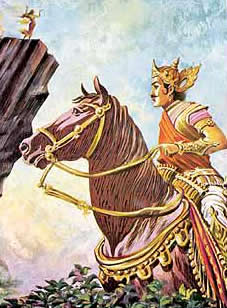
Starting as the teenage ruler of a small Indian state, Harsha came close to recreating the mighty Gupta Empire. In 606, Harsha Vardhana became ruler of Thaneswar, a small state located in the Punjab between the northern Indus and northwestern Ganges Valley. He married into the neighboring Maukhar kingdom and relocated to the capital at Kanauj. In 618, Harsha invaded the Gauda kingdom with 50,000 troops, 20,000 horsemen, and 5,000 elephants. Centered in modern Bangladesh, Gauda was responsible for the death of Harsha’s older brother. “The elephants were never unharnessed and the soldiers never unhelmeted” until Harsha made Gauda his tributary.
Generally, however, Harsha preferred to negotiate his neighbors into his empire as allies rather than use force. These tactics made the rulers of Sindh, Ghujarat, and Valabhi become vassals (Samantas), placing much of the Indus Valley and the Arabian Sea coast under his sway. However, Pulakeshin II, ruler of the Decca plains south of the Narmada River, spurned Harsha’s diplomacy. In 633, when Harsha attempted to march into Pulakeshin’s territory, the Deccans forced him back across the Narmada. Three years later, he expanded his empire to the east, moving down from Gauda to annex more of Bengali coast.
Later foreign sources comment on the extent of Harsha’s cavalry (100,000 horse and 60,000 elephants). Despite this great host, Harsha preferred a feudal-confederal decentralism over militaristic despotism. Patron of arts, culture, public charities, and scholarship, historical sources are kind to his memory. Nonetheless, Harsha was assassinated in 647 and his empire disintegrated almost immediately.